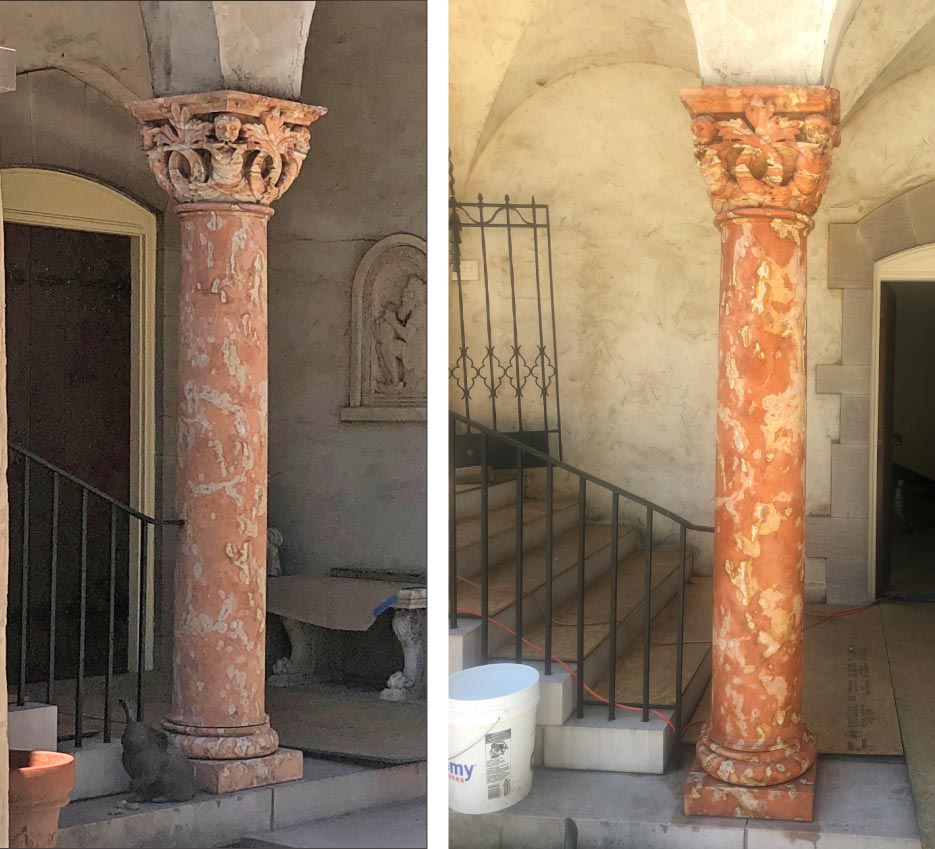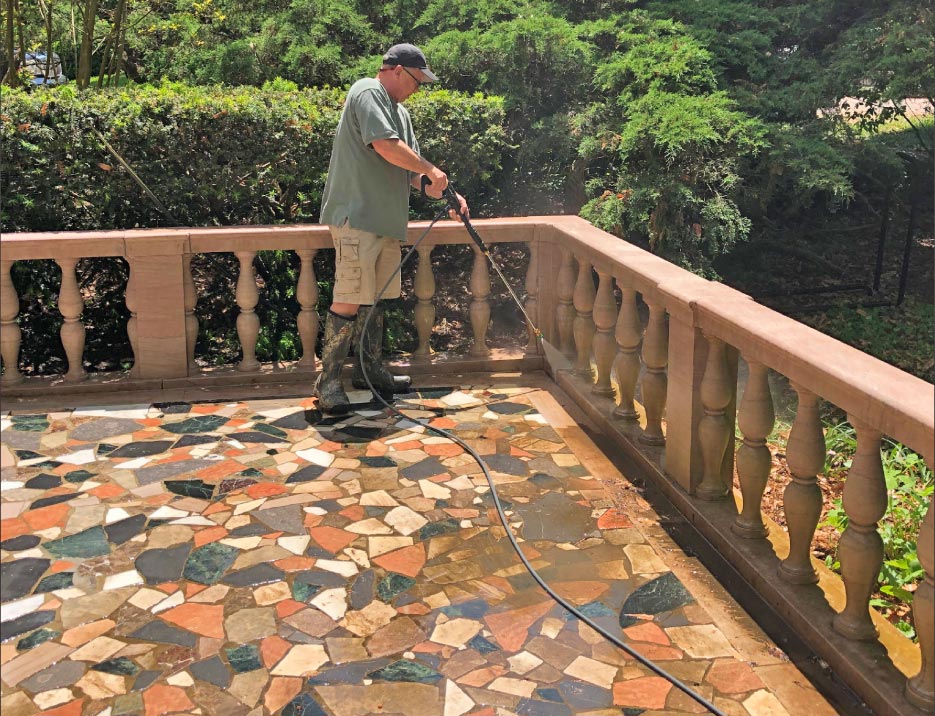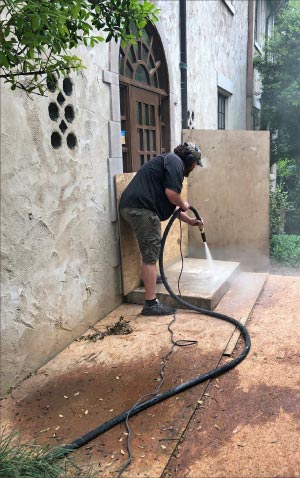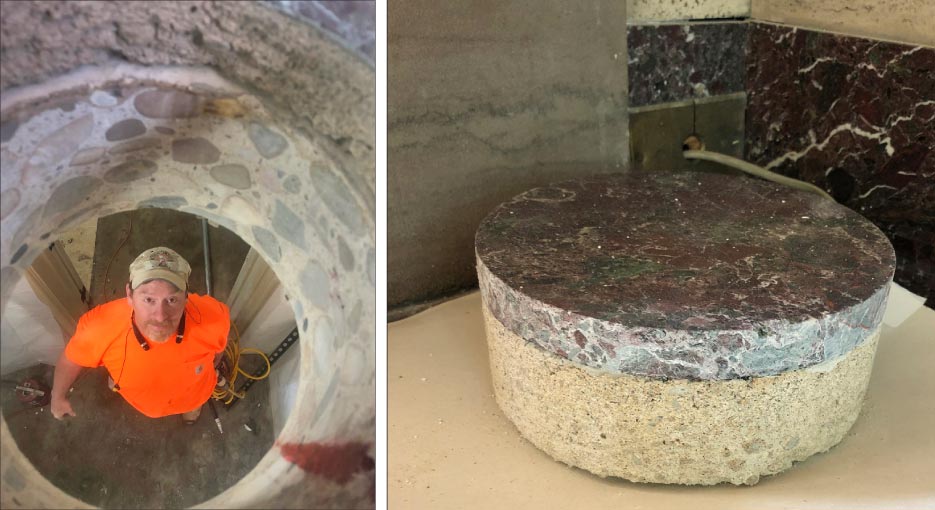Stone Restoration and Maintenance Corner: What Are Ancillary Projects?
Bob Murrell
M3 Technologies
Photos by Bob Murrell
As a restoration professional, I always strive to provide assistance to clients regarding most anything stone restoration related. This includes many options that we may not even normally offer as part of our service. I call these ancillary projects.
Some examples: I personally do not install stone. I’m not talking about a tile or two, which most restoration pros will happily do.
 |
|
Travertine column before restoration (left) and after (right) cleaning and chemical consolidation treatment. |
I suggest leaving the installation, especially of dimensional stone (slab material), to those professionals who do this type of work routinely. These have to be blind hole drilled and anchored properly, and all according to code. As another example, there is a building located downtown in a medium-sized city (which I won’t mention), where the granite cladding began to fail and fall off. Needless to say, this was a major and potentially deadly mistake.
I will, however, schedule and manage the replacement of dimensional stone for the client. So basically, I would subcontract these types of operations that are out of the normal range of restoration offerings. There are really not that many services in the restoration field that restoration professionals don’t offer. I mean, I have done core drilling for new faucets or accessories on countertops, but I would not attempt 16-inch core drilling for new HVAC work — know what I mean?
A recent project had just that: giant core drilling for new HVAC ducting through solid marble and concrete. Special equipment and experience is required for this type of operation. So this was subcontracted by a professional core drilling company.
 |
|
Pressure washing a quilted marble patio and stone balustrade. Care must be taken to avoid blasting out the mortar in installations, especially old ones. |
 |
|
Soda blast cleaning and texturizing a dimensional marble stoop. The client requested a high grip surface profile without grinding marks left behind, so a blasting professional with the specialized equipment was contracted to handle this small but important project. Note the plywood panels laid down to protect adjacent surfaces. |
Pressure washing is and should be part of the restoration professional’s offering, in most cases. However, not everyone has a $35,000 truck-mounted piece of equipment, with water recovery. In some areas, where the EPA and other code officials are strict, effluent to storm drains is prohibited. Many cities have these issues where the water from cleaning must be recovered and disposed of properly.
Stone patios and walkways are typically pressure washed with a 3,500 psi machine. Care must be taken in order to avoid blasting out the mortar and/or grout from certain installations, especially older ones. Use of the correct tips is application specific, as well. In some cases, the smaller electric pressure washers are sufficient, easier to handle, and pose less of a hazard than the commercial grade higher- pressure machines.
A telescoping wand was used on a recent project to remove both mold and leftover growth from ivy on a stucco and stone exterior wall that was up to 30 feet high. Talk about strenuous work, that wand was extremely difficult to manage!
Another type of work which may need to be subcontracted might be sand, bead, or soda blasting, for certain applications. This is another example of a $35k machine required to accomplish the job. This was the case on a small porch stoop in which the client requested a high grip surface profile, without grinding marks left behind. The blasting professional was called and made quick work of this small project.
Of course we have all repaired, removed, and replaced grout in situations that required it. The same is true for caulking on countertops, shower stalls, and other applications. Dremel tools and grout saws are very handy pieces of equipment to have in your tool box for these types of applications. Of course, you will need a dental pick set and some manual grout scraping and removal tools, too.
On a recent project, a team of unexperienced general laborers was used to remove and replace the caulk on some exterior solid marble staircases. They managed to absolutely destroy the risers and treads by using a screw or nail to gouge out the old caulk. Of course that’s when we, as restoration professionals are called in. Fixing someone else’s screw up (pun intended) will cost the project manager more than just having the Restoration Pro do it right, in the first place.
For this particular problem, the marble was actually textured, but had to be gently ground to minimize flattening of the stone. Once the scratching was minimized, a color enhancer was used to blend the stone, virtually hiding the mistake.
 |
|
Few companies in the stone trades keep a 16-inch bore core bit in their toolbox. This job required a specialist with the right tools to smoothly penetrate through marble and concrete to install new HVAC ductwork. |
On another project, a consolidation product was used to strengthen an old exterior red travertine column, which had begun deteriorating and was starting to crumble. This type of product is somewhat technical and requires multiple applications over a period of days, to be the most effective. Consolidators typically use a silicon dioxide to help naturally replace the natural binding materials of the stone, concrete, stucco, brick and other porous masonry materials. Please check with the supplier of the consolidator prior to use.
There are clear coatings designed for marble and other sensitive surfaces to prevent etching and reduce scratching. These coatings are somewhat complicated to apply and usually require professional training. The stone is honed and the coating is sprayed on the surface, much like painting a car. Then the coating is finished to a polish.
There are many evolutions that the stone restoration professional may run into while in the field. On, We are more than capable of handling many of them, while others may require the subcontracting of a project specific specialist. In any case, I suggest that you always try your best to help the client with their stone issues, and maybe you can make a few dollars as well by subcontracting out some of the most specialized tasks.
As always, I recommend submitting a test area to confirm the results and the procedure prior to starting a stone or hard surface restoration or maintenance project (oh, and use your smartphone to take plenty of before and after pics!). Also the best way to help ensure success is by partnering with a good distributor that knows the business. They can help with technical support, product purchase decisions, logistics, and other pertinent project information.
Bob Murrell has worked in the natural stone industry for over 40 years and is well known for his expertise in natural stone, tile and decorative concrete restoration and maintenance. He helped develop some of the main products and processes which revolutionized the industry, and is currently the Director of Operations for M3 Technologies.